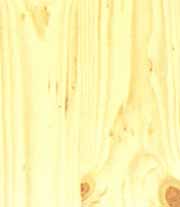The Properties of Wood and Timber for Interior Design and Decorating
Properties of Timber and Wood
You have probably heard of many properties of wood and timber and have a general idea as to what they mean. We have gathered the most commonly used terms with their meaning and origin so that you can understand and put into practice these terms when selecting and specifying wood and timbers for design work.
Flexibility and Strength of Wood / Timber
This property is due to the (abundance) of interlocked fibers to provide strength. The direction and structure of the cells also effects the strength of the timber, straight grained timber is stronger than a cross grained or wavy timber. Defects like cracks, decay or a knot will decrease the strength of the timber.

Knots in the pine decrease the strength of the timber.
Toughness of Wood Timber
Toughness is the ability of timber to change its shape. It is dependent on the strength and elasticity so that it can be bent without breaking. A timber that has been used for steam bent work is Beech as it has these two properties. A timber is tough if it has an interlocked cell structure that makes it difficult to split.
Durability of Wood / Timber
Durability is being able to withstand disease or insect attack. Impregnated in the cell walls during growth are chemical substances, oils, resins that cause the timber to be durable. Impregnating the wood with a suitable preservative can increase durability. Softwoods/Hardwoods and light or heavy timbers can all be durable.
Hardness of Wood / Timber
This can be gauged in different ways. The timbers resistance to nails, the difficulty in sawing and working, and the resistance to wear. As a rule, hardwoods are more resistant to wear than softwoods as they have small thick walled cells, and the softwoods generally have thin walled cells. The thickness of the cell wall and the smallness of the cell cavities make the wood hard. The moisture content of the wood and the maturity of the timber also affects the hardness.
Density or Weight of Wood / Timber
Heavy timbers have thick cell walls and small cell cavities; this means that it is made up of a lot of wood substance and little air. Whereas light timbers have thin cell walls and large cavities, these have little wood and a lot of air. Balsa is an excellent example of light timber as only 7% of its volume is solid wood, the remaining is air cavities.
Wood / Timber’s Resistance to Fire
All timber or wood burns, but as we have learnt, different timbers can have extremely different properties. The denser the timber the longer it takes to ignite. Jarrah, Teak and Kauri are all dense and partially fire resistant and can be used in construction. Chemical treatments are available to apply to timber providing added fire resistances as well as specialised fire resistant paint products.
Wood / Timber’s Odour
Whilst being planed or sawn several timbers have strong distinctive smells. Certain oils being present in the wood usually cause this. Some people can recognise a timber from its scent alone. Some scents are very useful for example cedar and camphorwood have an odour that is pleasant to us but not to insects therefore they are an ideal timber for making clothes chests. This works both ways as some timbers have a very unpleasant odour, e.g. the Australian Walnut and Stinkwood, which would not be desirable as clothes chests.
The Colors of Wood / Timber
The most common way to identify timber is when it is freshly cut and is consistent in color. The color does not last unless the timber is sealed by polishing or waxing as its exposure to air changes its color and depending on the timber it may bleach or darken. (Cedar darkens) As we have learnt previously, sapwood is lighter in colour than heartwood. Sapwoods color can range from white to pale reddish yellow. Heartwood is darker because it has gone through the process of chemical changes from the dying of sapwood cells to the changing to heartwood.
The Texture of Wood / Timber
There are numerous timber textures, uniform, coarse, medium, fine and even. Once again this is distinguished from the size of the cell cavities. Oak has a coarse texture – large cell cavities. Kauri has a fine texture – small cell cavities.
Timber / Wood Grain
Grain is used to describe the cells and their direction in the timber. The tree is made up of millions of tiny narrow cells. Their length generally follow the same direction as the length of the tree. Deviations in direction often occur and are therefore not always consistent grain direction within the tree. Knots or irregular growth of a tree may also distort grain direction.
Articles on Timber or Wood next page is Wood Characteristics
